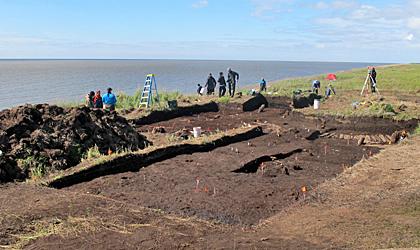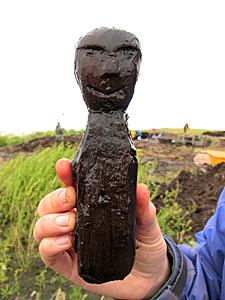Ben Miller
Source - http://www.culture24.org.uk/history-and-heritage/archaeology/art463387-Aberdeen-archaeologists-rescue-melting-village

The Nunalleq dig site in Alaska, where archaeologists have had a revelatory time © The Nunalleq Project / ELLA
When the residents of Quinhagak, a city in Alaska of less than 700 people, called in archaeologists from the University of Aberdeen in 2009, they might not have anticipated their investigation yielding instant results.
The Scottish and indigenous archaeological teams wanted to carry out a rescue dig on a coastline rapidly being lost to global warming. They found a 700-year-old village site within hours of their first incision, as well as hundreds of immaculate artefacts preserved by permafrost.
“The first thing we found was a complete wooden doll with the original paint still on it,” says Dr Rick Knecht, the project leader.
“It’s quite incredible – leather, fur, plants, even 400-year-old grass that has been completely preserved intact because they’ve been frozen all this time.
“Instead of looking at stones and bones, like archaeologists usually look at, we’ve got wooden artefacts - pieces of organic material.”

Co-investigator Dr Charlotta Hillerdal holds a magnificently-preserved wooden mask depicting a human in the act of transforming into a wolf or dog-like animal. The mask still bore traces of silvery coloured paint when it was found© The Nunalleq Project / ELLA
A thaw meant the precious discoveries were suddenly at the mercy of the elements.
“The exposed archaeological site was rapidly eroding away because of global warming – you’ve got rising sea level, and the permafrost is melting,” says Knecht.
“The soil is held together by the ice, so when the ice melts the soil becomes very vulnerable to marine erosion.
“Since we started in 2009, the shoreline has retreated a full 10 metres. This is happening all around the arctic and because these were coastal people, the archaeological record is lost with it.
“But it’s not just an archaeological record – it’s one of the clearest records of the past that we know of anywhere in the north.”
Village elders named the site Nunalleq – the old village – and will have samples of human hair, ceremonial face masks and an ivory carving of a legendary river monster returned to them once they have been preserved and archived at the university.
“Cut strands of human hair, the waste from haircuts, were found all across the site, sitting on the preserved house floors,” points out Dr Kate Britton, who says the locks were “rather like the sweepings you get at a barber’s shop.”
“By taking a long strand of hair we can sequentially sample it and get a month-by-month or even bi-monthly record of dietary change, so you get a year in the life of this individual, in terms of what they ate.
“What we found in the earliest phases of the site is that, despite the very seasonal nature of the availability of wild foods in this region, there seems to be very little change in diet throughout the year – a mixed diet of fish like salmon, caribou, and some marine mammals.
“The lack of variation in diet suggests they were preserving and storing the food and eating it all year around – this really attests to adaptations these early groups made to life in the arctic.”

More than 60 wooden dolls have been recovered from the site - some were made as playthings, others for ritual and ceremonial purposes© The Nunalleq Project / ELLA
Little has been known about the Yup’ik people, who live in an area of north America three times the size of Scotland. They originally moved there between 1300 and 1650, covering the Little Ice Age – a period of rapid global climate change during the early 15th century.
The researchers are excited to have won a £1.1 million grant from the Arts and Humanities Research Council, which they say will allow them to stay on the “melting village” for four years and identify similar sites across the world.
“We want to see how diet changed throughout the Little Ice Age,” says Britton.
“The grant will allow us to look more closely at the palaeoenvironment and food technologies at the site, such as pottery and hunting implements.
“We’ll combine this with the isotopes, and get a better look at how climate change influenced subsistence strategies and what made it onto the menu.
“Although there is an overall ongoing trend of global warming, climate change is not just about temperatures increasing, but also about more erratic and sometimes extreme weather conditions.
“We are all seeing the evidence of this here in the UK right now with storms and flooding, and the plummeting temperatures across North America.”
One of her colleagues, Dr Charlotta Hillerdal, has enjoyed forming a “true partnership” with groups and schools in Quinhagak.
“Throughout this project it has become evident that archaeological remains and artefacts in Nunalleq and their fascinating tale have the ability to bring people together,” she reflects, calling Yup’ik heritage “dynamic and powerful”.
“The artefacts evoke the memories of some and arouse the curiosity of others. They inspire stories that could otherwise not have been told and cultural meetings that without would not have taken place, as well as increase our own understanding of a fascinating Yup’ik past independent of colonial practices.
“As an archaeologist it’s great to see how archaeology can become a part of a living heritage, and witness the power these artefacts holds as cultural objects.”
 Drs Hillerdal, Forbes and Knecht remove a large wooden bowl from the site© The Nunalleq Project / ELLA
Drs Hillerdal, Forbes and Knecht remove a large wooden bowl from the site© The Nunalleq Project / ELLA
The artefacts could help reintroduce lost skills into the Alaskan community.
“I think the dig is helping to get the local young people interested in their heritage,” feels Knecht.
“A group of youngsters recently asked the village elders for permission to form a traditional dance group – something that was supressed by the missionaries more than a century ago.
“They did their first dance last year and the first song was about the storms washing the site away, and this year they did their first dance in Quinhagak itself – the first in 100 years – and they did it when we showed our summer’s finds to the community.
“It’s ironic that climate change is bringing about this thaw, which in itself is helping us answer questions about how these people coped with climate change hundreds of years ago and may help us plan for similar conditions in the future.
“The site is a little time capsule that we can tap into, to infer changes that may happen in the future with regards to the availability of different animal species, as climate shifts changes in animal behaviour, and how past humans responded to those changes.
“It’s been a complete revelation to both scientists and the local native community.”
He says the “fantastic” grant will lead to further expeditions.
“What’s happening at Nunalleq, with climate change, will be repeated right across North America and into Greenland. Further north there are places in arctic coastlines that have lost a mile of coastline. That’s their entire archaeological record gone.
“There are many more sites like Nunalleq that we just can’t get to, or haven’t yet located, so part of the grant involves surveying the land to identify other sites and provide training to locals so they can take steps to preserve artefacts and record new sites in the future.”
“Looking at the past will help us see what parts of the ecosystem are most sensitive to temperature change and hopefully provide a predictive model for what’s going to happen to the modern subsistence diet of animals and plants that people in this region are completely dependent on.”